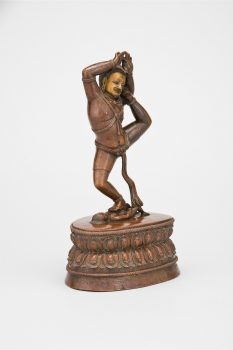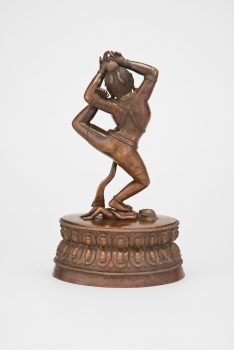Tibet
ca. 16th century




Tibet
ca. 16th century




Legendary men and women called mahasiddhas, or great spiritually accomplished ones, are considered to be among the first teachers of Tantric Buddhist practices. Usually of ordinary occupations, such as wandering monk, weaver, or farmer, they are often depicted in various yogic positions, flying or dancing, wearing little or no clothing, drinking alcohol, and consorting with members of the opposite sex. In their wide variety and unconventional behavior the mahasiddhas exemplify Tantric Buddhist practices, which offer many paths to realization. They are celebrated as real people who embodied enlightenment through Tantric practice.The Indian siddha depicted here in an active posture is known for his many yogic feats. It is said that he could manifest his body in many places at the same time and live in many bodily forms in widely disparate lands simultaneously.
A religious movement that originated in India around the fifth to seventh century with sacred writings and esoteric teachings and practices transmitted from teacher to student through initiation. These remain an important part of Hinduism and Buddhism today.
The transmission of teachings from one generation to the next, from teacher to student, traced all the way back to the Buddha without interruption. A complete lineage is essential in Tantric Buddhist practices as it makes the blessings of the teaching more powerful.
Himalayan art includes portraits of legendary and historical humans, including accomplished religious teachers (lamas), the Buddha’s original disciples (arhats), and spiritually accomplished tantric masters (mahasiddhas).
Today, Tibetans primarily inhabit the Tibetan Plateau, situated between the Himalayan mountain range and the Indian subcontinent to the west, Chinese cultural regions to the east, and Mongolian cultural regions to the northeast. During the 7th to 9th century, Tibetan rulers expanded their empire across Central Asia, and established Buddhism as the state religion.
Get the latest news and stories from the Rubin, plus occasional information on how to support our work.